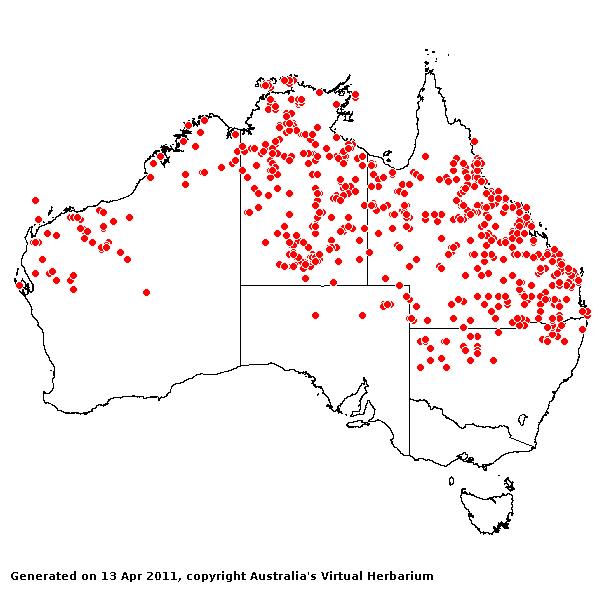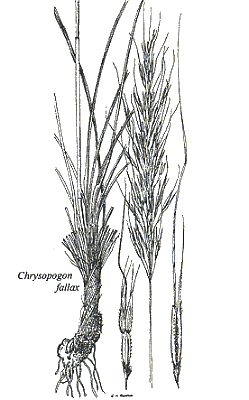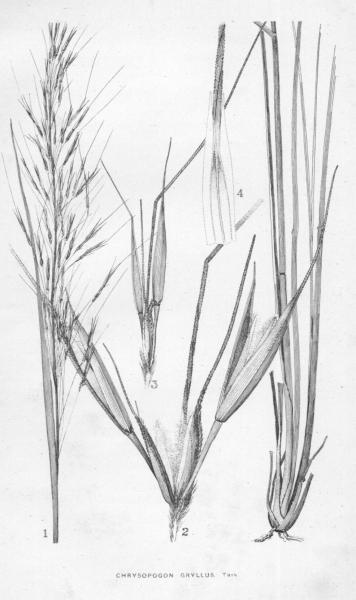Chrysopogon fallax S. T. Blake, nom superfl. Univ. Queensland Dept. Biol. Pap 2(3): 9 (1944).
Classification. (GPWG 2001) : Subfamily Panicoideae. Andropogoneae.
Type of Basionym or Protologue Information: HT: S.T. Blake 8108, 18 Mar 1935, Australia: Queensland: Leichhardt Dist. (BRI-8033; IT: K, NSW, US-1865513).
Key references (books and floras): [1810]. R.Brown, Prodromus (199 as Holcus gryllus), [1878] G.Bentham, Flora Australiensis 7 (537 as Chysopogon gryllus auct.), [1952] C.A.Gardner, Flora of Western Australia 1 Gramineae (323), [1981] M.Lazarides in J.Jessop (ed)., Flora of Central Australia (491), [2002] D.Sharp & B.K.Simon, AusGrass, Grasses of Australia, [2006] J.Jessop, G.R.M.Dashorst, F.M.James, Grasses of South Australia (513), [2008] S.W.L.Jacobs, R.D.B.Walley & D.J.B.Wheeler, Grasses of New South Wales (186).
Illustrations: [1952] C.A.Gardner, Flora of Western Australia 1 Gramineae (321, Pl. 94), [1983] J.C.Tothill & J.B.Hacker, Grasses of Southern Queensland (160), [2006] J.Jessop, G.R.M.Dashorst, F.M.James, Grasses of South Australia (512, Fig. 439), [1984] N.T.Burbidge. rev. S.W.L.Jacobs, Australian Grasses (91).
Habit. Perennial. Culms erect or geniculately ascending, 30–120 cm tall, 3–5 -noded. Mid-culm internodes glabrous or pubescent. Mid-culm nodes glabrous. Lateral branches simple or sparsely branched or branched. Leaf-sheaths glabrous on surface or hairy. Ligule a fringed membrane, a ciliolate membrane. Leaf-blades 5–45 cm long, 2–7 mm wide. Leaf-blade surface smooth or scaberulous, glabrous or indumented.
Inflorescence. Inflorescence compound, a panicle of rames. Panicle lanceolate, 7–21 cm long, 2.5–7 cm wide. Rhachis obsolete.
Spikelets. Spikelets sessile, 1 in the cluster. Companion spikelets pedicelled, 2 in the cluster. Companion spikelets developed, containing empty lemmas or male, 9–14 mm long. Companion spikelet glumes muticous or awned. Fertile spikelets 2-flowered, the lower floret barren (rarely male), the upper fertile, comprising 1 basal sterile florets, comprising 1 fertile floret(s), without rachilla extension, lanceolate, laterally compressed, 9–14 mm long.
Glumes. Glumes dissimilar, firmer than fertile lemma. Lower glume oblong, cartilaginous, without keels, 5–7 -nerved. Upper glume oblong, keeled, 1-keeled, 3–5 -nerved. Upper glume surface scabrous. Upper glume apex awned. Florets. Basal sterile florets 1, barren, without significant palea. Lemma of lower sterile floret hyaline, 2–3 -nerved.
Fertile lemma 5.5–7 mm long, without keel, 1 -nerved. Lemma apex dentate, awned, 1 -awned. Median (principal) awn from a sinus, 20–45 mm long overall, with a twisted column. Palea 0–2 -nerved. Grain 3.5–4 mm long.
Continental Distribution: Australasia.
Australian Distribution: Western Australia, Northern Territory, South Australia, Queensland, New South Wales.
Western Australia: Fortescue, Ashburton, Carnarvon, Austin. Northern Territory: Darwin & Gulf, Victoria River, Barkly Tableland, Central Australia North, Central Australia South. South Australia: Lake Eyre. Queensland: Burke, Burnett, Cook, Darling Downs, Gregory North, Leichhardt, Maranoa, Mitchell, Moreton, North Kennedy, Port Curtis, South Kennedy, Warrego, Wide Bay, Gregory South. New South Wales: Northern Tablelands, North-Western Slopes, North-Western Plains, North Far Western Plains.
Notes. Found in all mainland states except Vic. in subtropical and tropical areas on a variety of soils; mainly in open forests. It has some forage value but not very productive and is resistant to drought and heavy grazing. Flowers Oct.--July.





